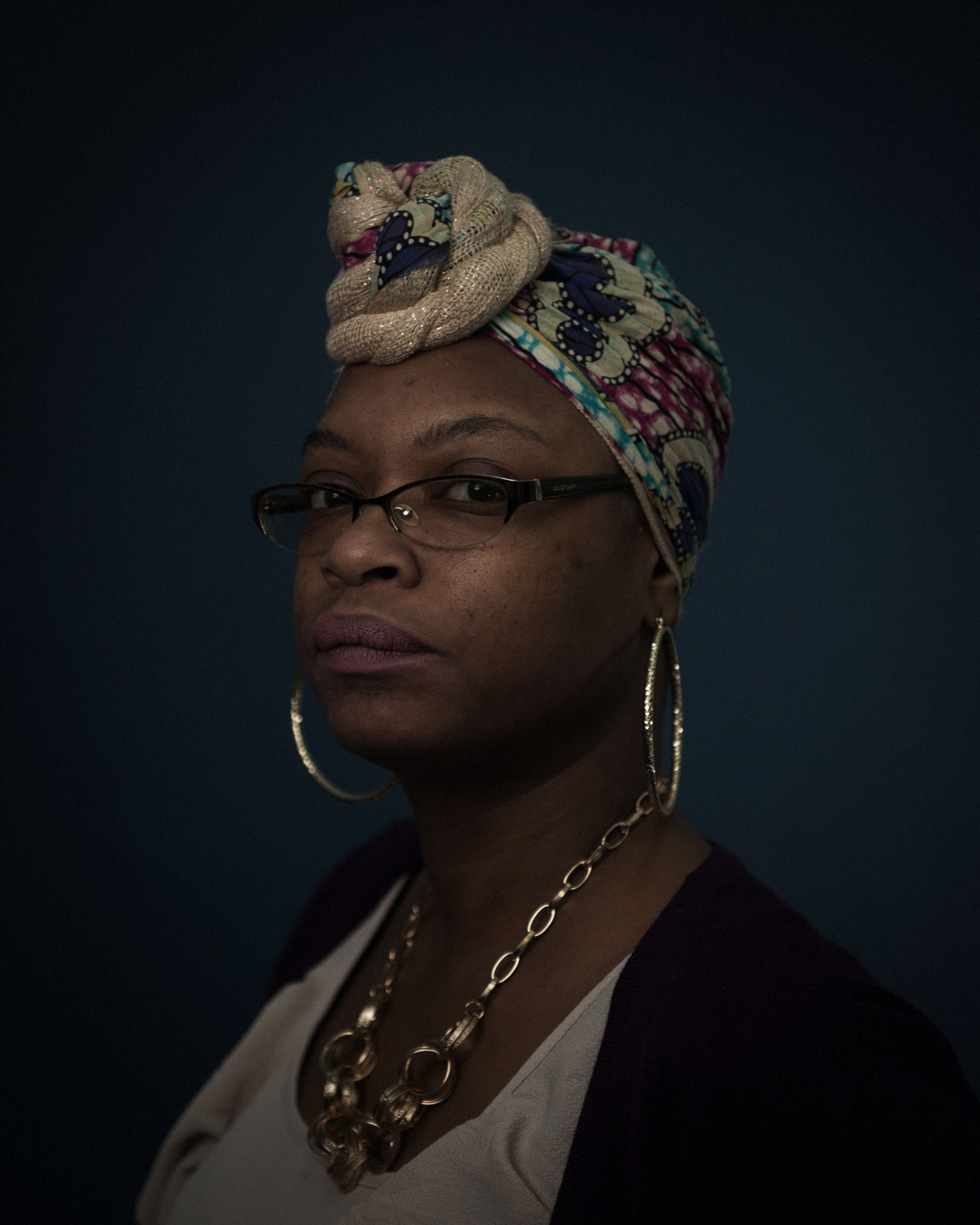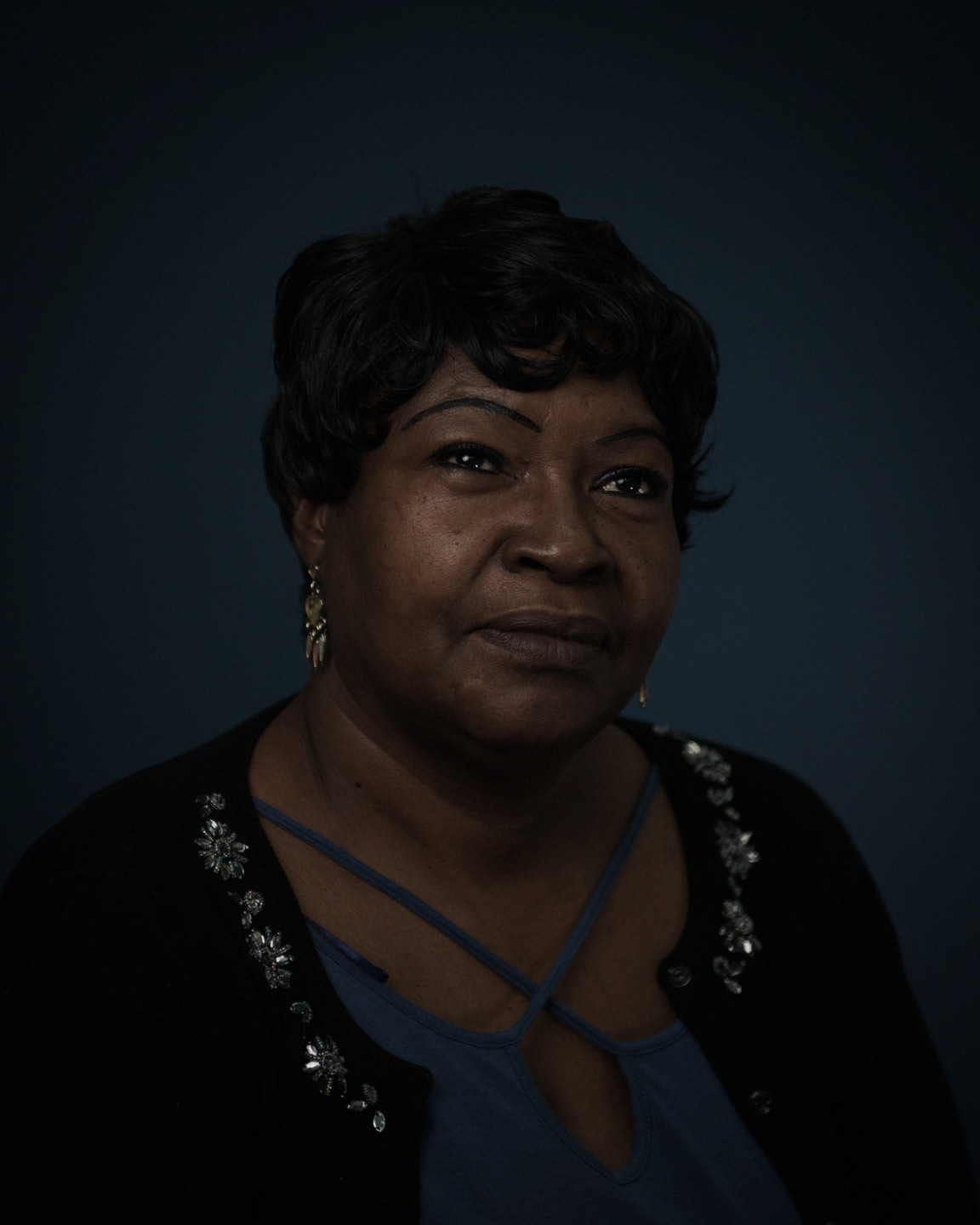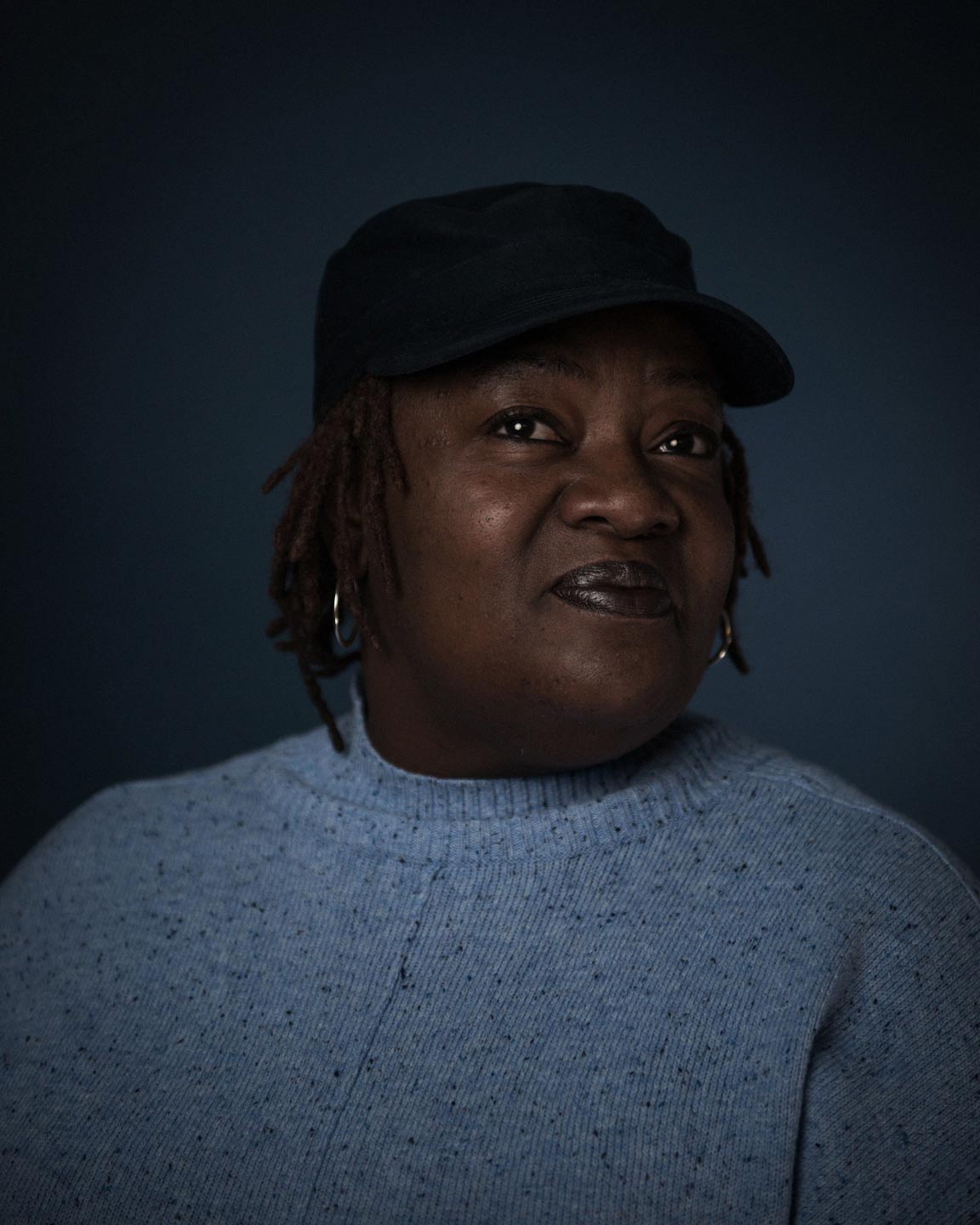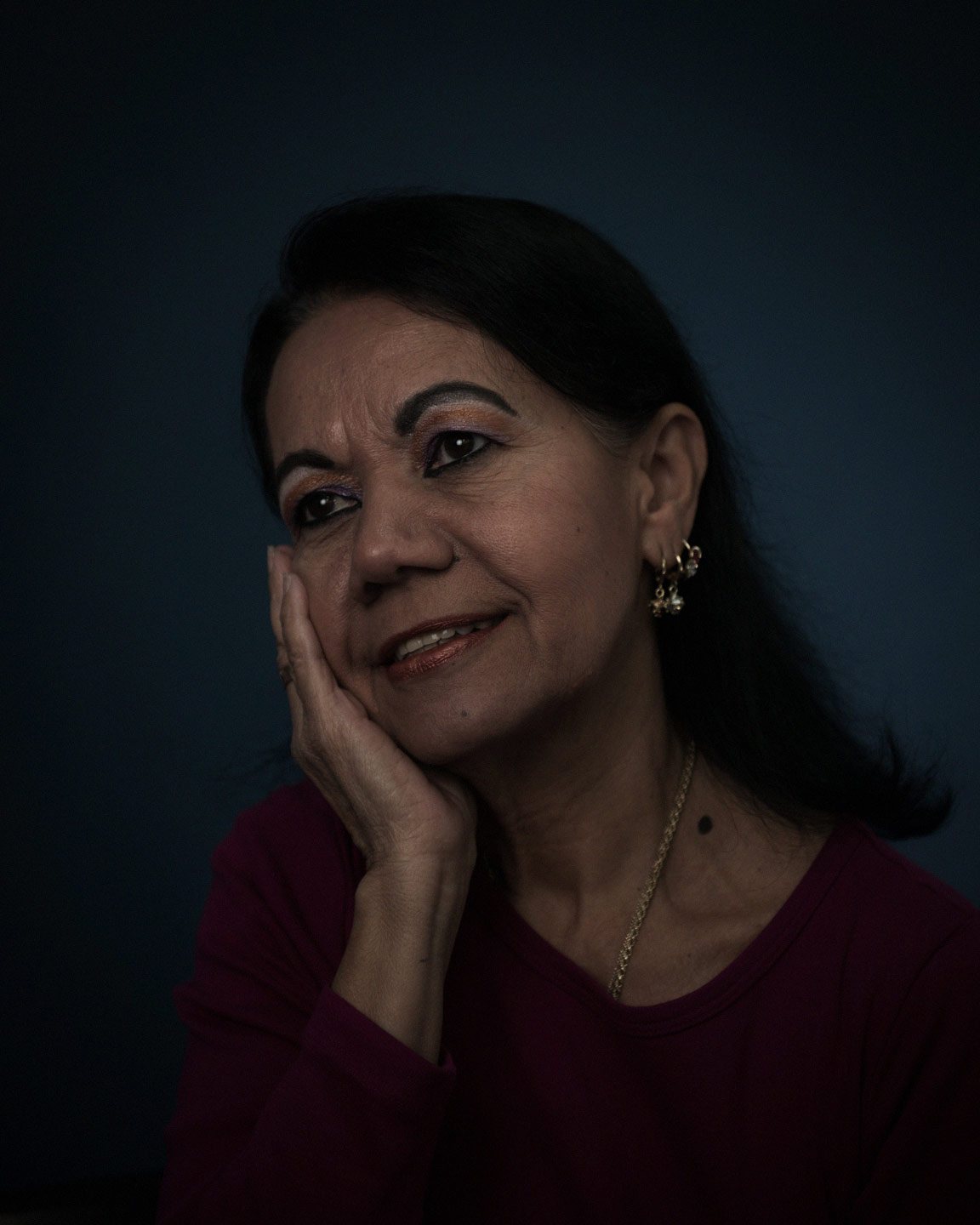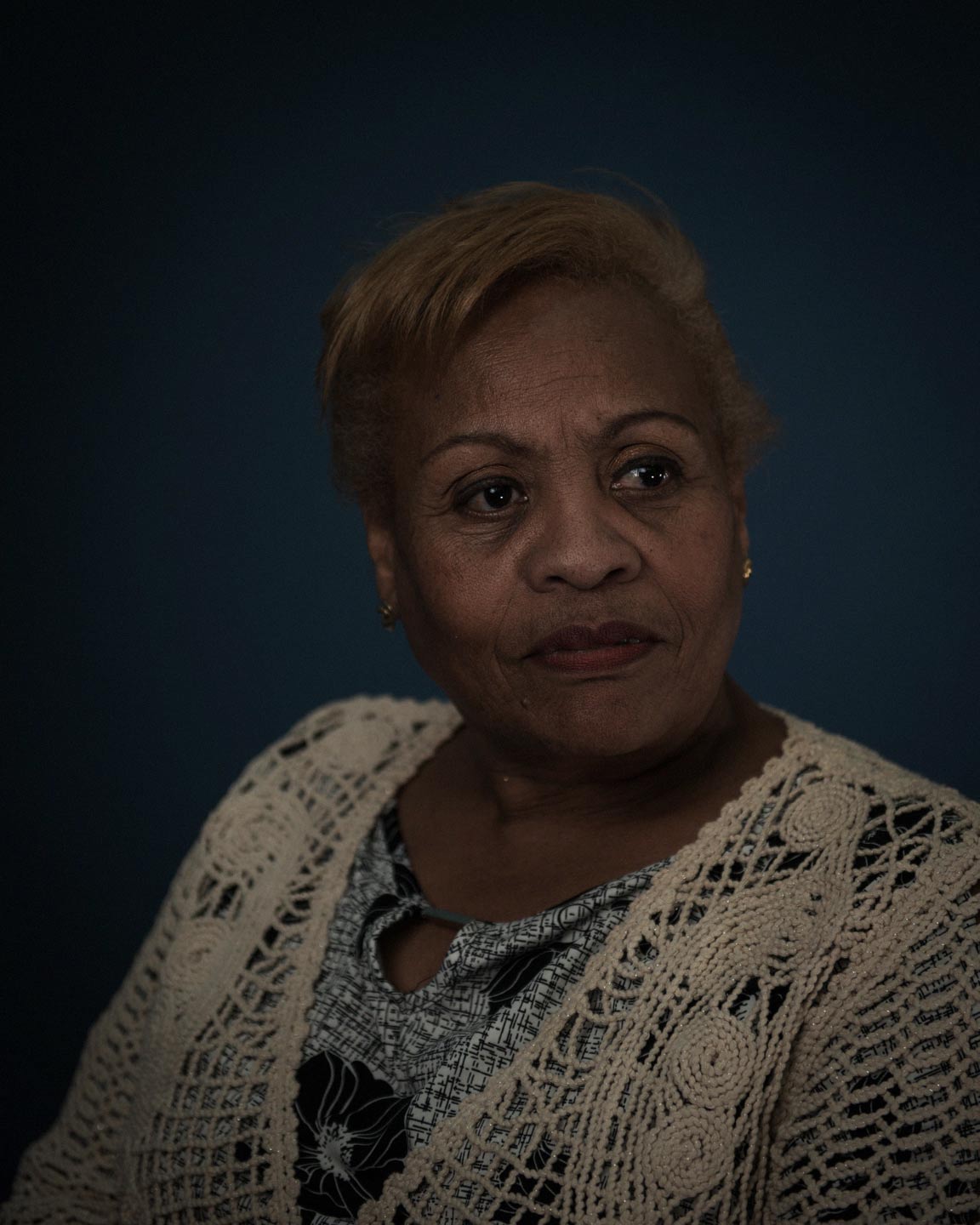This article is by Sophie Kasakove, with photography by Tracie Williams.
In the meeting room at Red Hook Initiative (RHI)—a Brooklyn community-development nonprofit dedicated to youth empowerment, social justice, and sustainability—a large painting hangs high up on the wall, bordered by the words “rebound and rebuild.” It shows the neighborhood of Red Hook in the aftermath of Superstorm Sandy, with waves crashing on a row of sandbags, as cans of food, light bulbs, and batteries lie strewn about haphazardly. Last summer, a group of residents of Red Hook’s public-housing developments, just across the street from RHI, gathered here for the orientation meeting of RHI’s 10-week emergency-preparedness training, called “Local Leaders.”
Tevina Willis, a Local Leaders facilitator, says that the first question she asks at an orientation is, “Where were you during Hurricane Sandy?” If people hesitate to answer, she’ll start with her own story—of how she and her neighbors ran up and down the stairs carrying giant cases of water, worked together to collect information about available resources, and played games late at night by candlelight when they were too anxious to sleep. She likes asking this question first, because it gets people who might not know each other to open up. But more than that, it gets people thinking about another set of questions—about what work they’ve already done to help their neighbors during moments of crisis and about the structural deficiencies in public housing that make this work necessary in the first place.
Willis was no stranger to storms when she moved into Red Hook Houses 10 years ago. She grew up in Coney Island, where hurricanes were a regular occurrence and didn’t faze her family, who would just tape paper to the windows and go on with their day. So when she received an evacuation order from the city on October 28, 2012, the day before Superstorm Sandy hit New York, she, like the large majority of people in the city’s evacuation zones, ignored it. But when the storm began sweeping over the city, she realized this wasn’t just another storm. All of the lights in her 14-floor building went out, the elevator froze, the heat shut off. She gathered blankets for warmth, as a refrigerator’s worth of food started to spoil.
The storm was more intense than residents had expected, but more importantly, they were more on their own than they had expected. “No one knocked to see if any of their tenants were okay,” Willis recalls.
Instead, Willis says she got a knock on her door from the New York City Housing Authority’s Inspector General—the department that enforces NYCHA rules—asking her whether or not she had spoken to reporters who had been visiting the buildings. “I said ‘Where’s my water? What do you care what I’m telling a news reporter?’” If there was any emergency-action plan in effect, it was completely opaque to Willis and her neighbors. “I don’t think there was any protocol except to evacuate. It was, ‘We told you to leave and you chose to stay, so fuck it.’” (Such neglect wasn’t universal: Aixa Torres, the Resident Association president at Alfred E. Smith Houses on Manhattan’s Lower East Side, said that the NYCHA manager for her building was on site throughout the storm and its aftermath, sleeping on the floor and taking care of residents’ requests.)
Sandy was the strongest storm to hit the New York metropolitan area in decades, and the climate-disrupting effects of global warming are making it just a matter of time before the region suffers more powerful and more damaging storms. Sandy caused at least $19 billion worth of damage across the city, and highlighted the fact that in one of the most unequal cities in the country, the ability to adapt to climate change closely tracks income. For some of the city’s poorest residents, those who live in public housing, the infrastructure improvements, safety protocols, and community coordination needed to ride out climate change’s greatest hazards are still not there. As the city struggles to learn from Sandy, and create resilient, sustainable public housing, residents fear that the next storm may come too soon.
NYCHA is the largest public-housing authority in the country, with more than 400,000 residents living in over 300 developments across the city. The system was strained long before Sandy—NYCHA has suffered a $3 billion loss in federal funding since 2001, and a study of NYCHA’s needs conducted in 2011, the year before Sandy, estimated that the agency needed $16.6 billion to carry out repairs and renovations to its properties over the next five years. According to NYCHA, more than 280,000 repairs were needed citywide that year, with an average of eight pending work orders per apartment—estimated at an average of $2,900 per unit.
When Sandy hit the next year, it made all of this worse, and residents are still living with the fallout. At Red Hook Houses, six years after the storm, temporary boilers still sit between the buildings in what used to be green space. Mold grows over water-damaged walls. Promises for protection remain unfilled. “It’s never been the same since Sandy,” said Shaquana Cooke, a life-long resident of Red Hook Houses. “I’m still kind of devastated by it, because I feel like we haven’t really recovered.”
From the beginning, Sandy’s impacts were disproportionately felt by public-housing residents: In 2012, New York City Housing Authority buildings were home to approximately 5 percent of the city’s population, but NYCHA buildings sustained more than 15 percent of the damages citywide. In total, approximately 80,000 residents in several hundred NYCHA buildings lost basic services like electricity, hot water, and elevators, many for weeks on end.
These disproportionate effects are far from coincidental. Historically, “the waterfront was the place the city put things it didn’t want to see,” says Roland Lewis, CEO of the Waterfront Alliance, a coalition of organizations focused on making New York’s waterfront accessible and resilient. “It was a place you put the highways, the railroads, the ships, the industry, and the projects.” The legacies of this decision-making have been made increasingly visible as storms surge with unprecedented force through public housing across the country, from North Carolina, to Texas, to Florida. In NYC, NYCHA apartments make up nearly one-fifth of the housing units that lie within the floodplain designated by FEMA.
In Brooklyn in the 1930s, this “out of sight, out of mind” logic dictated the isolation of public-housing residents in the poor, low-lying, water-locked neighborhood of Red Hook. Today, with 6,000 public-housing residents constituting close to 70 percent of its population, the neighborhood is known across the city as the casualty of perhaps one of Robert Moses’s most flagrant urban incisions: Since the completion of the Brooklyn-Queens Expressway in the 1950s, the neighborhood has been cut off from public transportation, grocery stores, and other services. But Hurricane Sandy revealed a vulnerability on the neighborhood’s other borders. Because the area on which Red Hook is built is largely man-made out of landfills on top of marshy land and tidal ponds, the surge swiftly submerged the neighborhood with up to six feet of water and exposed a number of NYCHA inadequacies lying just beneath the surface.
In the aftermath of Sandy, the city was abuzz with disaster-preparedness plans. There was talk of building massive seawalls, levees, and floodgates, developing wetlands on the tip of Manhattan to absorb storm surge, installing oyster beds or barrier islands in New York Harbor. In Red Hook, a plan to install floodwalls, raise streets, and improve drainage—called the Integrated Flood Protection System (IFPS)—was initially projected to be completed by 2016.
But, years later, little action has been taken to bring these proposals off the paper. The federal government agreed in 2014 to pay $335 million for the first phase of the “Big U”—a proposed 10-mile barrier extending around the southern half of Manhattan—but the project’s scope and other funding sources remain uncertain. Instead of the IFPS project, a temporary barrier of sandbags and tubes has been installed along Red Hook’s lowest-lying street, tall enough to protect from only the mildest of coastal storm surges.
“We were very skeptical when we saw the sandbags,” said Karen Blondel, an organizer with Fifth Avenue Committee, which provides support and services to low-income residents of South Brooklyn, and a resident of Red Hook Houses. Just the other week, she says, she took a walk over to the temporary barriers on Beard Street, and found the street filled with water, after heavy rainfall the previous night.
At the same time as the neighborhood- and citywide plans remain obscure, a cloud of skepticism also hangs over NYCHA’s ability to prepare its properties and residents for storm surges and other climate-related events.
A 2015 audit report of NYCHA by the New York City comptroller found a number of significant flaws in the agency’s emergency-response plan, including that NYCHA’s Emergency Procedures Manual did not “properly define the emergency management leadership” and that the agency was not complying with certain requirements, like maintaining accurate information on disabled tenants. NYCHA’s response to the report did little to build faith in the agency’s ability to learn from its mistakes. The agency stated: “We have enhanced our emergency management programs to plan for, manage and recovery [sic] from major disasters,” and claimed that “the findings and recommendations miss significant improvements NYCHA has made in relation to its emergency preparedness and response,” because of the time frame of the audit. In particular, the agency cited the creation of new plans and procedures for emergencies under the Office of Emergency Preparedness, established in June 2014.
Despite the fact that the auditing period extended eight months after OEP’s creation, NYCHA did not provide the comptroller’s office with these plans and procedures until a year and a half after the office was created. According to the comptroller’s report: “we are concerned that these plans and procedures were only very recently created and therefore they may not have the depth and consideration necessary to be effective.” In a November 2016 progress update sent to the comptroller’s office and obtained by The Nation, NYCHA said that it was in the process of rewriting its Organization for Emergencies section of its Emergency Procedures Manual, which would define the responsibilities of the agency’s leadership and employees during an emergency. The estimated completion for the document was set for the following month, December 2016, but NYCHA hasn’t provided the comptroller’s office nor tenant-advocacy groups like Red Hook Initiative or Fifth Avenue Committee with an updated version. The Nation’s request to NYCHA for this document did not receive a response at time of publication. The agency’s hurricane-emergencies section of this document hasn’t been updated since 2013. Its heat-emergency section hasn’t been updated since 2005, despite the fact that more than half of NYCHA residents live in the city’s most heat-vulnerable neighborhoods, and that less than half of units have air-conditioning.
“Emergencies can be life or death and not preparing to keep NYCHA developments protected isn’t an option,” New York City Comptroller Scott Stringer said in a statement sent to The Nation. “The vulnerable seniors, families and disabled residents living at NYCHA are relying on the City to help keep them safe. There’s no defense for the lack of transparency around NYCHA’s emergency planning and it raises very serious questions.”
Fifth Avenue Committee has consistently reached out to NYCHA requesting updated emergency protocols, to no avail. According to Sabine Aronowsky, community-development-program manager at Fifth Avenue Committee, the lack of clear emergency plans has continued to pose serious threats to residents’ safety. Last winter, thousands of public-housing residents across the city suffered through the city’s coldest week on recent record without heat. In Red Hook, the outages were the fault of inadequate temporary boilers that have serviced the developments since Sandy. Aronowsky says that there was no mechanism for residents to report heat outages beyond putting in a standard repair ticket, and residents had no way of knowing whether the ticket would be prioritized in the queue. In an October 2018 letter to NYCHA’s Committee on Public Housing Oversight, Fifth Avenue Committee wrote that the wait time on the central call-center help line during the cold snap was over 20 minutes, and that many residents were automatically disconnected before speaking with a NYCHA representative. “It really brought to light that public-housing residents and NYCHA were no better prepared than during Sandy,” said Aronowsky. “It seemed like not only were we equally unprepared, but systems were breaking down even further.” Earlier this month, on Martin Luther King Jr. Day—the coldest day of the season so far—over 10,000 NYCHA residents lost heat, hot water, or both.
Progress has been slightly more tangible in the realm of infrastructure. The devastating impact of the storm on NYCHA housing prompted the Federal Emergency Management Agency (FEMA) to dedicate $3.2 billion to the crumbling agency in 2015—the largest grant in FEMA’s history. Out of the 219 buildings to receive funds—which are required to go to post-Sandy recovery, not general maintenance—Red Hook was promised the largest sum: $560 million. With the money, the agency plans to install flood-proof doors to protect building entrances, add a new energy-efficient boiler system, raise generators above flood level, and even to elevate the common space between buildings—a design the agency calls “lily pads.” NYCHA broke ground on the first phase of the project in 2017—a $63 million project to install new roofs on all 28 buildings that will insulate the buildings from extreme cold and heat and protect against leaks.
But because of budgetary restrictions, the expected date of completion for the project has already been pushed back, from the 2021 date announced at the beginning of 2017 to 2022. The same is true in developments across the city: Of the 33 developments receiving FEMA funding post-Sandy, construction has been completed on only one. Willis, of the RHI Local Leaders program, says that the delays are disheartening. “In the beginning there was more of a sense of urgency. But we’ve been hearing this for over five years now.… People are tired of being lied to, of [having] their time being wasted with these promises of things being done and things that will come that are never coming,” she said. But she doesn’t find the delays surprising. “The city can say, ‘Oh, it’s slow ’cause it’s bureaucracy.’ But, no, they’re bullshitting, [it’s] ’cause it’s public housing.” The proof can be found, she says, in new luxury developments that have popped up rapid-fire across the neighborhood since Sandy—built on platforms to withstand flooding. “What I’d like [is] for the real work that can prevent us from flooding to begin,” Willis said. She knows that the clock is ticking: NYC could face Sandy-like floods every five years by 2045.
At the same time, many Red Hook Houses residents feel that the planned projects, even when completed, would leave major issues unaddressed. At an update meeting in October with NYCHA’s Recovery and Resilience Department, residents took the mic one after the other to voice concerns about the issues affecting their lives on sunny days, too: unreliable lights and elevators, leaky pipes, and mold. A 2014 survey of NYCHA residents in primary flood zones conducted by several local environmental justice-organizations found that 40 percent of respondents had a new repair need in their apartment as a result of Sandy. Forty-five percent of respondents said that they had visible mold in their apartment after Sandy, compared with 34 percent who said they had mold in their apartment prior to Sandy. Of those who reported having mold in their apartment, 38 percent said that NYCHA had done nothing to address the problem.
“My walls look like jigsaw puzzles,” said Bernelle Mitchell, who’s lived in Red Hook Houses for 26 years. “Everyone knows you have to start within to bring the beauty out. The inside is falling in. They want these ‘lily pads,’ but [by then], we’ll be hit again.”
Joy Sinderbrand, vice president for NYCHA’s Recovery and Resilience Department, says that she hears these types of complaints often, and that the root of the problem lies with the restrictive nature of the FEMA grant. “There is a lot of cognizance [in NYCHA] that the way the federal government gives out disaster-recovery money is not with the kind of discretion that one would love to have. Nobody said, ‘What are your worst problems and what would you like to solve here?’ It was, ‘Repair the damage from Sandy and protect from the next Sandy.’ And that was very prescriptive.”
For residents, however, the distinction between the FEMA grant’s limitations and the agency’s general neglect of chronic damage (the backlog for repairs is reported to be over 150,000 citywide) is blurry. According to Afua Atta-Mensah, executive director of Community Voices Heard, a community group that works on NYCHA tenant organizing, the overall dysfunction of NYCHA has made residents skeptical of the resiliency plans. “The sustainability plan is not real, because the day-to-day plan is not working,” said Atta-Mensah. “No one has a lot of faith in the housing authority. During a storm the elevator probably won’t work, because tomorrow the elevator probably won’t work.”
Juana Narvaez realized quickly that help wasn’t coming, and she didn’t waste a minute. As soon as Sandy hit, Narvaez—who grew up in Puerto Rico and moved to Red Hook 42 years ago, when she was 23—was on her feet, running up and down the stairs of her six-floor building and door to door, asking people if they needed anything. She took care of an elderly woman in a wheelchair who was stranded in her apartment and gathered food from volunteers at a nearby church to distribute to her neighbors.
It was clear that Narvaez and others like her were not just being good neighbors during Sandy—they were filling essential roles severely neglected by the city. In the absence of clear direction, these volunteers had mostly improvised, responding to whatever crises presented themselves with whatever means were available. “In some ways, I believe we were really fortunate in Red Hook,” said Karen Blondel. “Red Hook is an area cut off from most of Brooklyn, and other people don’t usually come here.… But the fact that we were by ourselves actually put us in a better position: We were already relying on each other, so it wasn’t hard for us to organize in those first 72 hours that the government wasn’t there for us.”
After the chaos settled, though, residents began wondering how they could move beyond improvisation. “After sitting there without heat, hot water, electricity or working elevators for 29 days, I wanted to know what we could do to be prepared,” said Willis. So, in 2014, Red Hook Initiative, which had become a hub for volunteers from all over the city during Sandy, launched a training program for residents to learn emergency-preparedness and community-organizing skills. So far, nearly 250 public-housing residents have gone through the 10-week Local Leaders course, and now graduates of the first class have begun serving as trainers themselves.
The work people like Narvaez did during Sandy has been formalized: As a Local Leader, she is responsible for keeping everyone in her building informed about where to evacuate to before an emergency, and where to get resources and services during and after one. Their knowledge of how to ready themselves for an emergency has been formalized, too. “Whenever I hear the news that another storm is happening in Florida or Puerto Rico, I’m nervous,” Narvaez said. “But now I’m prepared—I have a bag of my IDs, medications, and places I might be able to go to. So, I’m nervous, but not like before, because I know I’m prepared.”
The goal of the program is to build resilience through skills and preparation, but also through building stronger relationships among residents. “People feel like resiliency is lights and walls and flood zones and large equipment,” said Jill Eisenhard, director of Red Hook Initiative. But “if you can’t rely on the larger system, how do we make sure we can respond?”
Graduates of the Local Leaders program are under no illusions that they can take responsibility for all of the necessary fixes: removing mold from crumbling walls, coordinating the evacuation of thousands of residents, keeping track of the medical needs of those who remain in their apartments.
But they do know that they can’t just wait around for NYCHA to make improvements.
“It won’t happen in five years, maybe in 20. Probably I won’t see it, but the next generation will,” says Yolanda Diaz, a resident of Red Hook Houses, who moved to New York from Puerto Rico 41 years ago.
“In the meantime, we’ll prepare ourselves with what we got, and so far, what we got is knowledge.”

